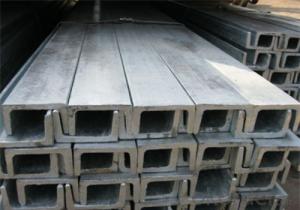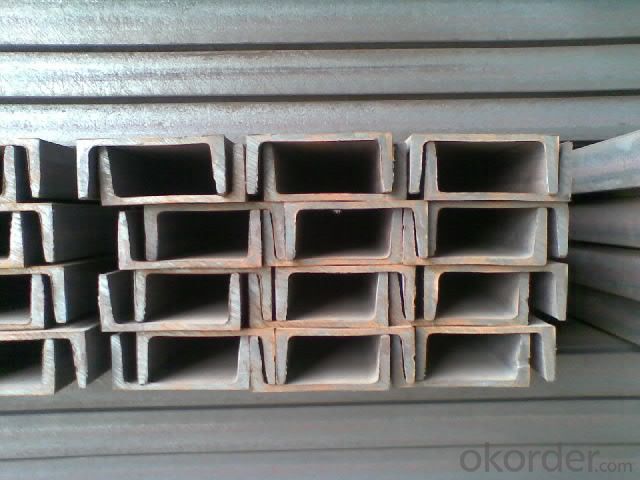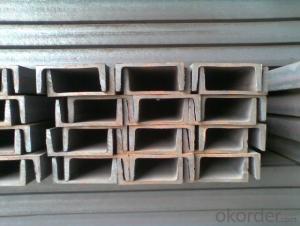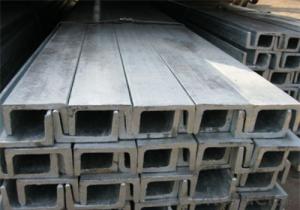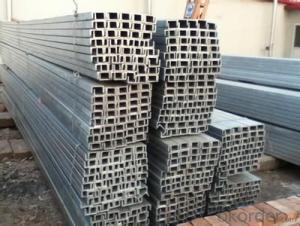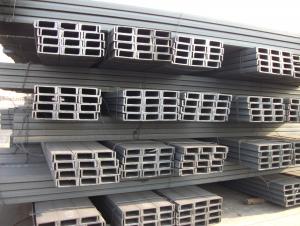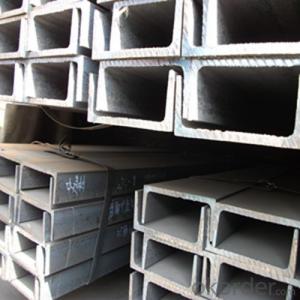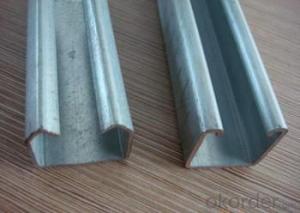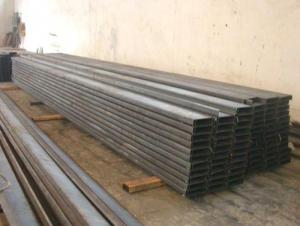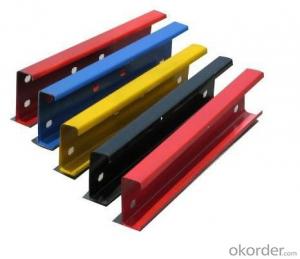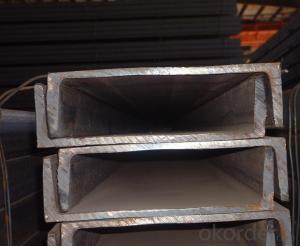U Channel Steel Mild Steel Size/Channel Steel Bar Sizes
- Loading Port:
- Tianjin
- Payment Terms:
- TT or LC
- Min Order Qty:
- 27 m.t.
- Supply Capability:
- 30000 m.t./month
OKorder Service Pledge
OKorder Financial Service
You Might Also Like
Product Description:
OKorder is offering U Channel Steel Mild Steel Size/Channel Steel Bar Sizes at great prices with worldwide shipping. Our supplier is a world-class manufacturer of steel, with our products utilized the world over. OKorder annually supplies products to European, North American and Asian markets. We provide quotations within 24 hours of receiving an inquiry and guarantee competitive prices.
Product Applications:
U Channel Steel Mild Steel Size/Channel Steel Bar Sizes are ideal for structural applications and are widely used in the construction of buildings and bridges, and the manufacturing, petrochemical, and transportation industries.
Product Advantages:
OKorder's U Channel Steel Mild Steel Size/Channel Steel Bar Sizes are durable, strong, and resist corrosion.
Main Product Features:
· Premium quality
· Prompt delivery & seaworthy packing (30 days after receiving deposit)
· Corrosion resistance
· Can be recycled and reused
· Mill test certification
· Professional Service
· Competitive pricing
Product Specifications:
Grade:Q195, Q215, Q235, Q345, SS400,S235JR,ST37-2 etc
Classification:Common channel and light channel
Channel according to the shape can be divided into four kinds: cold-formed channel equilateral, scalene cold-formed channel steel, cold-formed the curling channel steel, cold-formed outer edge channel
Model:5#-40#
Depth:50-400mm
Flange Width:37-104mm
Web Thickness:4.5-14.5mm
Weight:5.44-65.208kg/m
Length:6m, 9m, 12m or as your requirement
Business Model:Manufacturer and Exporter
production technology:
a)hot rolled u channel (ordinary channel & light channel)
b) cold-formed u channel
Surface Finish:
Painted
Pre-Galvanized
Hot Dipped Galvanized:
for outdoor use to BS EN 1461-1999, between 60 and 80 microns thick
Back to Back available
Electro zinc plated – for indoor use to BS EN 12329-2000
Note:hole channel can alsobe done as your request.
The hole size: 10*25 / 14*28 / 11*25 / 10.5*30 / 12*35mm
Application: Channel is mainly used for building structures, vehicle manufacturing, construction and other industries, such as fixed disk counters, channels and beam often used in conjunction.
FAQ:
Q1: Why buy Materials & Equipment from OKorder.com?
A1: All products offered byOKorder.com are carefully selected from China's most reliable manufacturing enterprises. Through its ISO certifications, OKorder.com adheres to the highest standards and a commitment to supply chain safety and customer satisfaction.
Q2: How do we guarantee the quality of our products?
A2: We have established an advanced quality management system which conducts strict quality tests at every step, from raw materials to the final product. At the same time, we provide extensive follow-up service assurances as required.
Q3: How soon can we receive the product after purchase?
A3: Within three days of placing an order, we will begin production. The specific shipping date is dependent upon international and government factors, but is typically 7 to 10 workdays.
Q4: What makes stainless steel stainless?
A4: Stainless steel must contain at least 10.5 % chromium. It is this element that reacts with the oxygen in the air to form a complex chrome-oxide surface layer that is invisible but strong enough to prevent further oxygen from "staining" (rusting) the surface. Higher levels of chromium and the addition of other alloying elements such as nickel and molybdenum enhance this surface layer and improve the corrosion resistance of the stainless material.
Q5: Can stainless steel rust?
A5: Stainless does not "rust" as you think of regular steel rusting with a red oxide on the surface that flakes off. If you see red rust it is probably due to some iron particles that have contaminated the surface of the stainless steel and it is these iron particles that are rusting. Look at the source of the rusting and see if you can remove it from the surface.
Images:
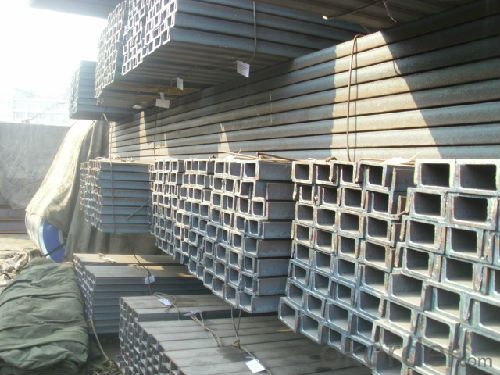
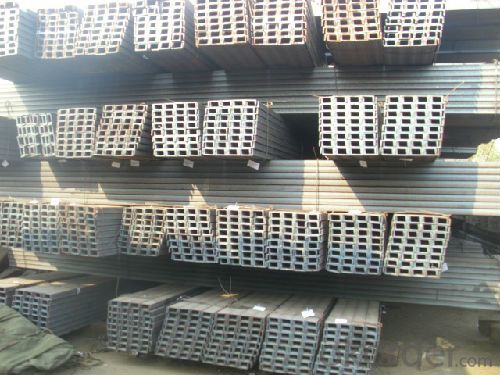
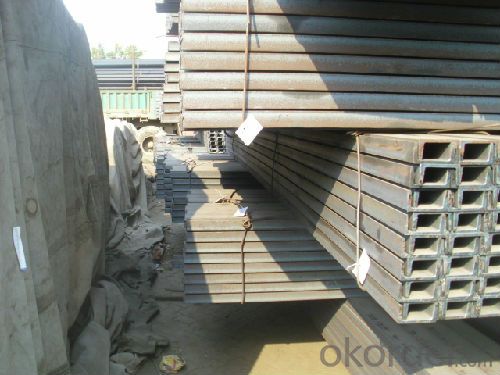
- Q: What are the applications of steel channels?
- Steel channels have a wide range of applications in various industries. They are commonly used as structural components in buildings and bridges, providing support and reinforcement. Steel channels are also utilized in the manufacturing of machinery and equipment, such as conveyor systems and material handling devices. Additionally, they are essential in the construction of vehicles, including cars, trucks, and ships, due to their strength and durability. Overall, steel channels play a crucial role in numerous sectors where strength, stability, and load-bearing capabilities are required.
- Q: Are steel channels suitable for use in agricultural applications?
- Yes, steel channels are suitable for use in agricultural applications. They are highly durable, strong, and resistant to environmental factors such as weather and pests. Steel channels can be used for various purposes in agriculture, including constructing animal enclosures, framing structures, and supporting equipment. Their versatility and reliability make them a popular choice in the agricultural industry.
- Q: What are the different methods of waterproofing steel channels?
- There are several different methods of waterproofing steel channels, depending on the specific requirements and conditions. Some of the most common methods include: 1. Coatings: Applying a waterproof coating on the surface of the steel channel is a common method. This can be done using various materials such as epoxy, polyurethane, or rubber-based coatings. These coatings form a protective barrier that prevents water from seeping into the steel and causing corrosion. 2. Sealants: Another effective method is using sealants to fill any gaps or joints in the steel channel. Silicone or polyurethane sealants are commonly used for this purpose. These sealants create a watertight seal that prevents water from entering the channels. 3. Membranes: Waterproofing membranes can be used on steel channels to provide a durable and long-lasting barrier against water. Membranes can be applied in different forms, such as liquid, sheet, or spray-applied membranes. These membranes adhere to the steel surface and create a waterproof layer. 4. Grouting: Injecting grout into the gaps and voids in the steel channels can help to seal them and prevent water infiltration. Cementitious grouts or epoxy-based grouts are commonly used for this method. Grouting helps to fill any cracks or openings in the steel channels, making them waterproof. 5. Cathodic protection: In cases where the steel channels are exposed to corrosive environments, cathodic protection can be used to prevent corrosion and subsequent water infiltration. This method involves creating an electrical current that counteracts the corrosion process and protects the steel from water damage. 6. Insulation: Insulating the steel channels can also contribute to waterproofing. Insulation helps to regulate the temperature of the channels, minimizing the risk of condensation and water accumulation. This method is particularly useful in areas where temperature fluctuations are significant. It is important to consider the specific requirements, budget, and environmental conditions when selecting the appropriate method of waterproofing for steel channels. Consulting with a professional or utilizing the expertise of a waterproofing specialist is recommended to ensure the most suitable method is chosen for the given application.
- Q: Channel 12, span 5 meters, how much weight can be carried?
- List the maximum bearing moment formula: M=1/8GL - -1/8gL -, (L=500cm, G: the calculation of the maximum uniform load, G: ibid.)
- Q: Can steel channels be used for supporting rooftop gardens?
- Yes, steel channels can be used for supporting rooftop gardens. Steel channels are strong and durable, making them suitable for supporting the weight and load of rooftop gardens. They provide structural support and stability, ensuring that the garden remains secure and stable on top of a building. Steel channels can be used to create raised beds or platforms for the garden, allowing for proper drainage and a solid foundation. Additionally, steel channels can be customized and fabricated to fit the specific requirements and dimensions of the rooftop garden, making them a versatile choice for this purpose.
- Q: Can steel channels be used for balcony supports?
- Yes, steel channels can be used for balcony supports. Steel channels are commonly used in construction and engineering projects for their strength and durability. They provide excellent support for structures, including balconies. When properly designed and installed, steel channels can effectively bear the weight and load of a balcony, ensuring its stability and safety. It is important to consult with a structural engineer or a professional contractor to determine the appropriate size and specification of the steel channels required for the specific balcony design and load requirements.
- Q: What are the different methods of corrosion protection for steel channels?
- There are several methods of corrosion protection for steel channels, including coating with paints or protective films, galvanizing, using sacrificial anodes, applying anti-corrosion primers, and utilizing cathodic protection.
- Q: 8 channel steel and 40*60 square steel tube, which is good in bending strength?
- Therefore, if the use of the channel sideways bending is much better (leg down), stands as the use of rectangular tube (leg sideways)
- Q: Can steel channels be used in the chemical manufacturing industry?
- Yes, steel channels can be used in the chemical manufacturing industry. Steel channels provide structural support and can be used in various applications such as building chemical storage tanks, platforms, walkways, and support structures for equipment and piping systems. Steel is known for its durability, strength, and corrosion resistance, making it suitable for chemical environments where exposure to corrosive substances and high temperatures is common. Additionally, steel channels can be customized and fabricated to meet specific design requirements, offering flexibility in construction and installation. Overall, steel channels are a reliable and versatile choice for the chemical manufacturing industry.
- Q: Can steel channels be used in soundproofing applications?
- Yes, steel channels can be used in soundproofing applications. Steel channels are often used as part of a structural framework for constructing walls or ceilings in soundproofing projects. They provide a sturdy and reliable framework that helps to reduce the transmission of sound vibrations. Additionally, steel channels can be used to mount soundproofing materials such as acoustic panels or insulation layers, further enhancing the soundproofing capabilities of a space. The use of steel channels in soundproofing applications can help create a more quiet and peaceful environment by minimizing the transfer of noise between different areas.
Send your message to us
U Channel Steel Mild Steel Size/Channel Steel Bar Sizes
- Loading Port:
- Tianjin
- Payment Terms:
- TT or LC
- Min Order Qty:
- 27 m.t.
- Supply Capability:
- 30000 m.t./month
OKorder Service Pledge
OKorder Financial Service
Similar products
Hot products
Hot Searches
Related keywords
